By now, you’re likely well aware that the state of mental health in America is very much like Jason Biggs’ apple pie — completely fucked. More that 40 percent of adults currently show signs of either depression, anxiety or both. One out of four young adults have experienced suicidal thoughts at some point during the pandemic, and deaths of despair have been on the rise ever since COVID changed how we live, work and connect.
All of this raises a lot of crucial questions about what we can do about it on a systemic level. But on an individual level, an answer to a much simpler question might help: What is wrong with all the people who aren’t anxious and depressed?
how are people out here with no therapy not taking any prescribed or illicit drugs just raw dogging reality
— giabuchi lastrassi (@jaboukie) January 23, 2019
When the past is traumatic, the present is precarious and the future is so uncertain, it’s easy to assume that anyone who feels a sense of inner peace is a complete sociopath. However, “it’s not true that people who feel okay feel nothing,” psychologist Amy Nasamran tells me.
So what do these Pollyannas (and Paulyannas) have that the rest of us don’t? And can we even access it if we wanted to?
Although genetics and childhood environment can help set the foundation, the mentally healthiest people tend to collect “protective factors” throughout their lives — and those are fair game for all of us, no matter what age. Unlike risk factors like trauma, isolation and substance abuse, protective factors refer to “supportive family and friends, a neighborhood they feel safe living in, financial security, better self-esteem or good problem-solving skills,” Nasamran says.
Protective factors work differently for different people and can change over time. Plenty of individuals who grew up in unstable homes find their protective factors in other places, like teachers, and plenty of people who had picture-perfect childhoods still accumulate too many risk factors on their own to be protected from mental illness. But all of them add up to the psychological trait of resilience, or the ability to endure and recover quickly from adversity.
One of the more game-changing protective factors is a secure attachment style. “One similarity that many ‘well-adjusted’ people share is that they grew up with what we call secure attachment,” therapist JF Benoist explains. The benefits of being securely attached are vast and well-documented, and from stable relationships to a solid sense of self, we all want what they have. The problem is that 56 percent of people are considered secure and the rest of us are dismissive-avoidant, anxious-preoccupied or fearful-avoidant, which are all risk factors for depression and anxiety.
An underrated trait secure people share is that they don’t over-identify with negative emotions the same way that anxious and depressed individuals do. “It’s not that they never feel sad, angry or fearful. It’s that they view these emotions as an essential part of life,” Benoist says. “When they experience something negative like getting laid off, they feel the hurt and tell themselves, ‘Okay, we’ll make our way through this.’ This is the opposite of how people with depression think.”
It’s difficult to completely change your attachment style, but a growing amount of research suggests that attachment is on a spectrum, and it’s entirely possible to move in the secure direction with the help of cognitive behavioral therapy, dialectical behavioral therapy, mindfulness and exposure to more healthy and stable relationships, romantic or otherwise.
The reason why CBT and mindfulness training like meditation come up all the time when discussing mental health is that they help people develop another trait shared by the mentally stable — the ability to stay present, particularly when they feel difficult emotions. On the flip side, “someone experiencing depression struggles being in the here and now. They don’t feel safe enough to experience their emotions in the present moment,” Benoist says. People who are less comfortable with their feelings in the moment might experience secondary emotions like anger. “Say you tell them something that makes them really mad — the person will often snap out of their depressed state for a moment,” Benoist adds. More often than not, though, the shame of getting angry helps these individuals slip right back into their depression.
If protective factors are the secret ingredient to a life without depression and anxiety, then that might also help to explain why mental health is so poor in the U.S. when so many people go without the most basic ones — food, shelter and a sense of security. But on a micro level, it’s an important reminder that these factors are more of a moving target than a constant. People lose risk factors and gain protective ones and vice versa, which is why even the most mentally well-adjusted person you know isn’t off the hook — they have to keep trying like the rest of us sad, anxious assholes.
“The good news is that these traits aren’t something you’re either born with or you miss out on,” Benoist assures me. “You can relearn these skills as an adult to change how you perceive emotions, guilt and shame and build a healthier overall mindset.”

